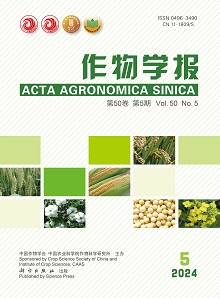-
Cloning and Expression of Transcription Factor TaMyb2s in Wheat
- JIA Dong-Sheng;MAO Xin-Guo;JING Rui-Lian;ZHANG Xiao-Ke;CHANG Xiao-Ping
-
Acta Agron Sin. 2008, 34(08):
1323-1329.
doi:10.3724/SP.J.1006.2008.01323
-
 Abstract
(
2052 )
Abstract
(
2052 )
 PDF (505KB)
(
1656
)
PDF (505KB)
(
1656
)
 Save
Save
-
Related Articles |
Metrics
MYB, one of the biggest transcription factor families, plays a crucial role in regulating cellular morphogenesis, secondary metabolism, responding to hormone and stress signals in plants. Several MYB transcription factors were involved in response to various abiotic stresses, such as drought, salinity, and low temperature. In this study, Hanxuan 10, a wheat (Triticum aestivum) cultivar with strong drought resistance, was employed to clone MYB gene using specific primers of TaMyb2. Three types of cDNA with high identities of 95.3%, 95.0%, and 99.6% to TaMyb2 were obtained, and designated TaMyb2-I, TaMyb2-II, and TaMyb2-III, respectively. Structure analysis indicated that the 3 types of TaMyb2 gene contained 2 MYB DNA-binding domains, and classified to R2R3-MYB sub-family. Phylogenetic analysis based on the putative amino acid sequences indicated that TaMyb2 were closer to HvMYB4 and OsMYB4 originated from barley and rice, respectively, while had less relations to ZmMYB39 from maize (Zea mays), AtMYB15 from Arabidopsis and NtMYB1 from tobacco (Nicotiana tabacum). No corre-sponding relationships were observed between the TaMyb2s and A, B, D genomes of common wheat according to phylogenetic analysis of common wheat and its relative species T. urartu, Aegilops speltoides, Ae. tauschii, T. dicoccoides, and T. araraticum. The different expression patterns of TaMyb2s were observed using real-time quantitative PCR methods, though all the 3 types were associated with osmotic stress. TaMyb2-III was the most sensitive to hyperosmolality, followed by TaMyb2-I. In addition, the differential expression levels of TaMyb2s were detected in tender tissues at different developmental stages in wheat. The highest expression level of TaMyb2s was identified at seedling stage, especially in seedling roots, and then decreased gradually from seedling to heading stage. High expression levels of TaMyb2-I and TaMyb2-III only presented before jointing stage, while TaMyb2-II held about 2 folds till heading stage.

 WeChat
WeChat
 WeChat
WeChat